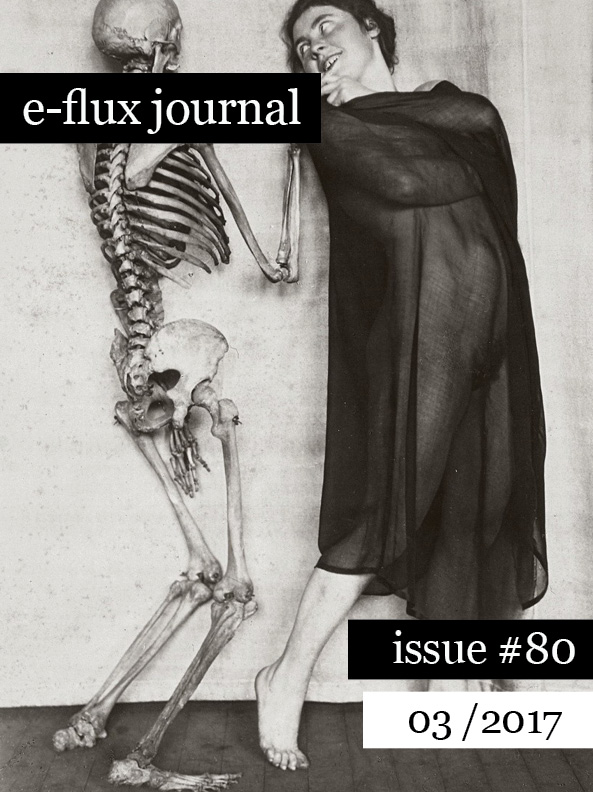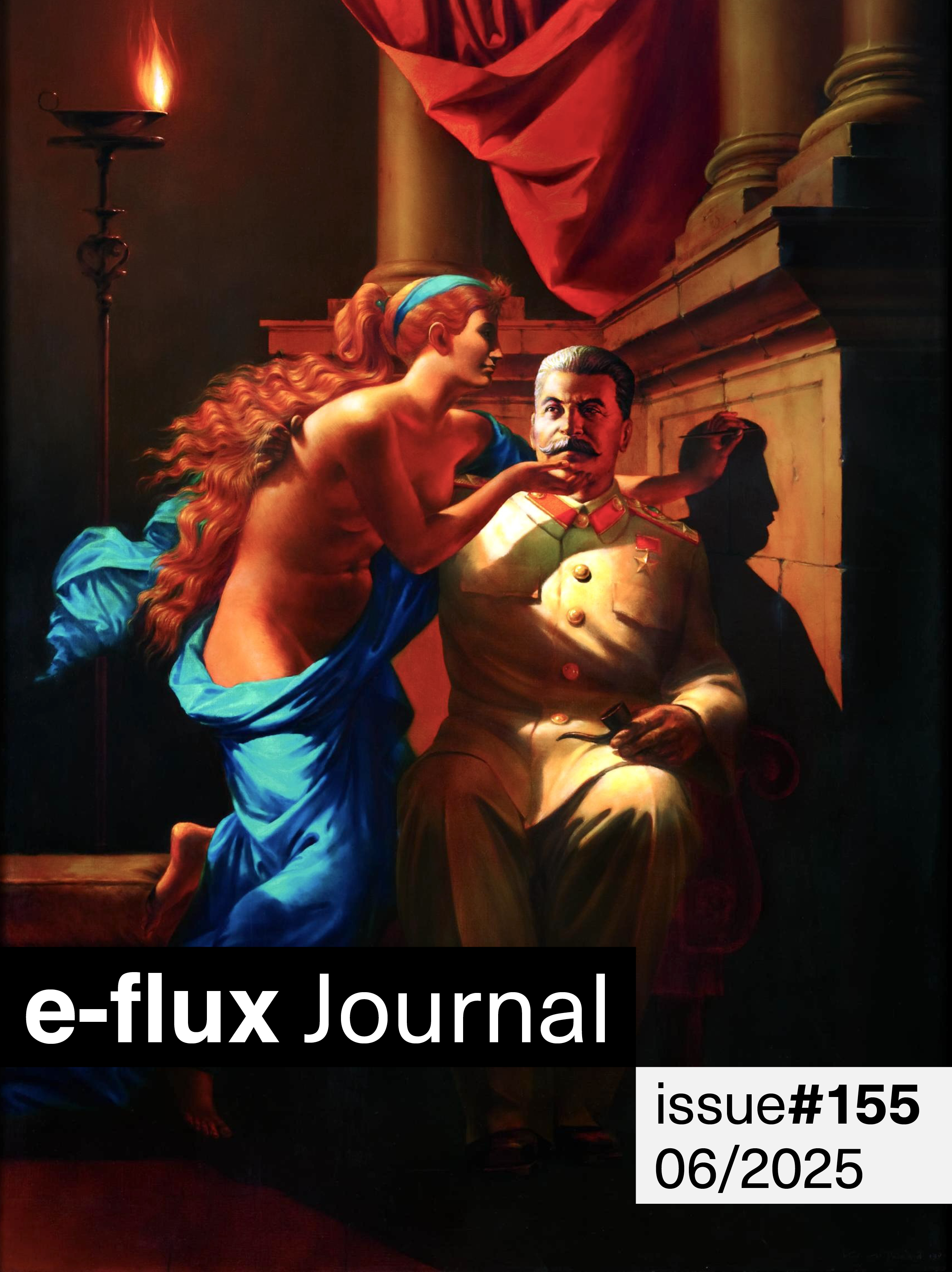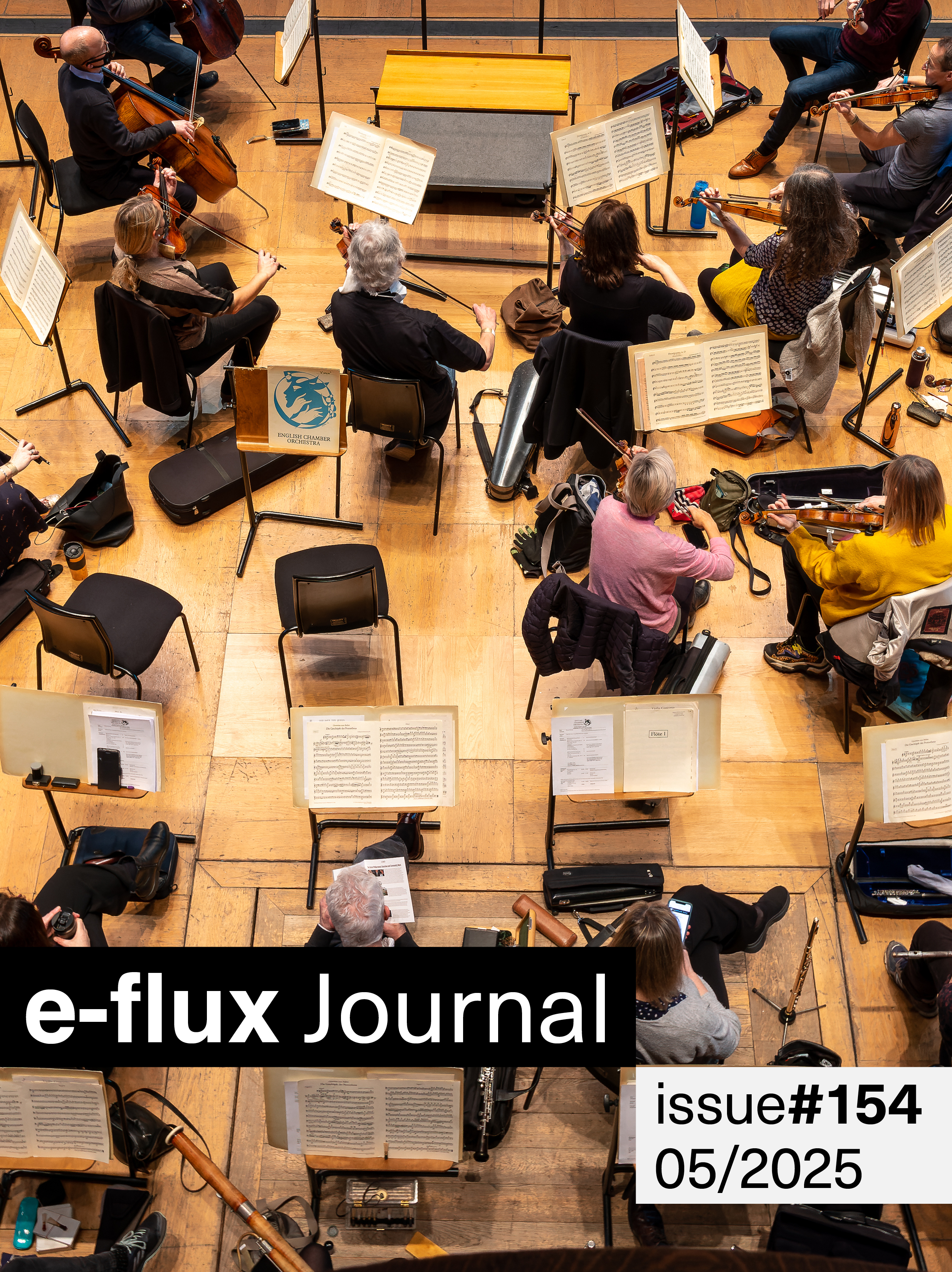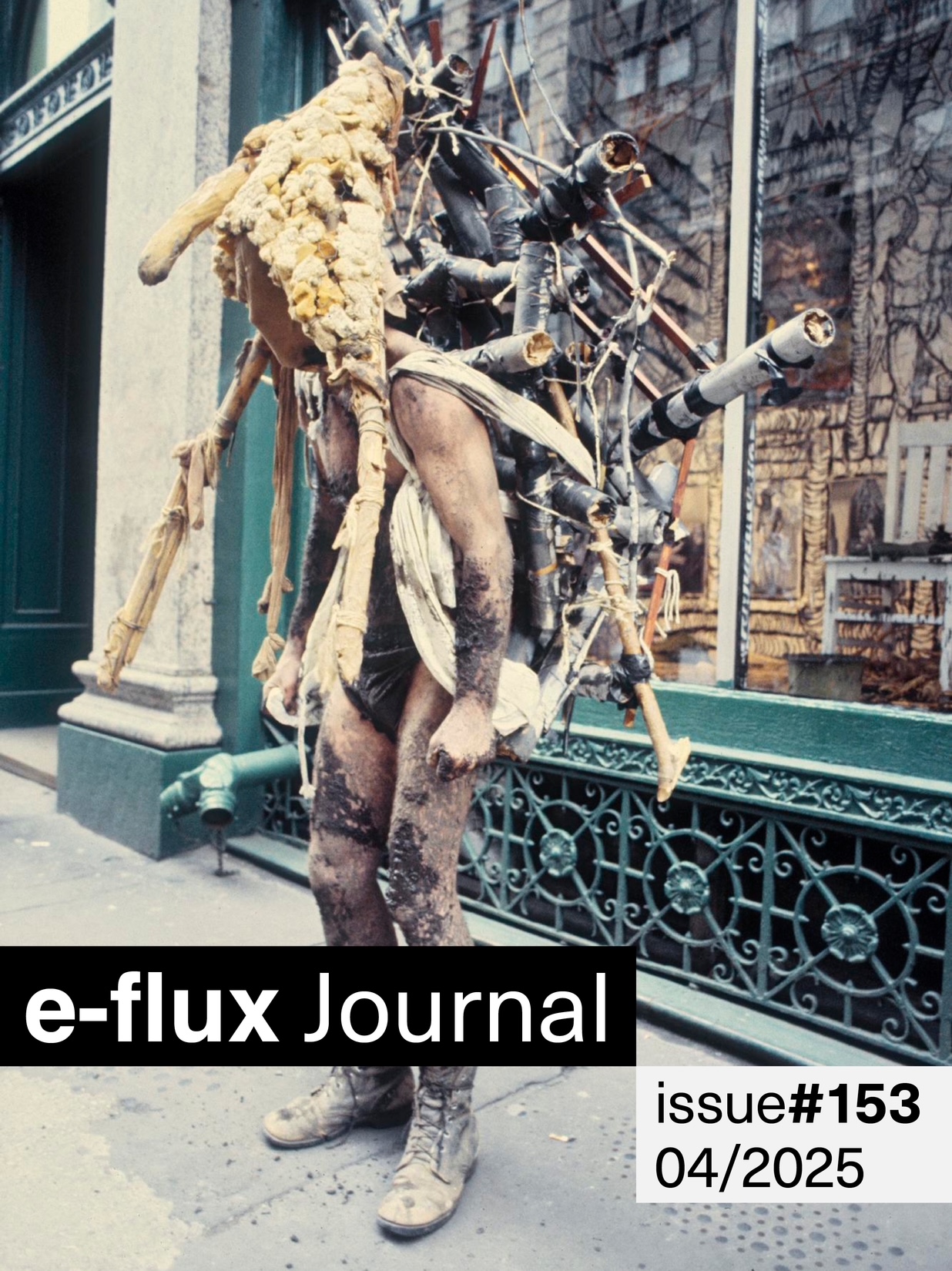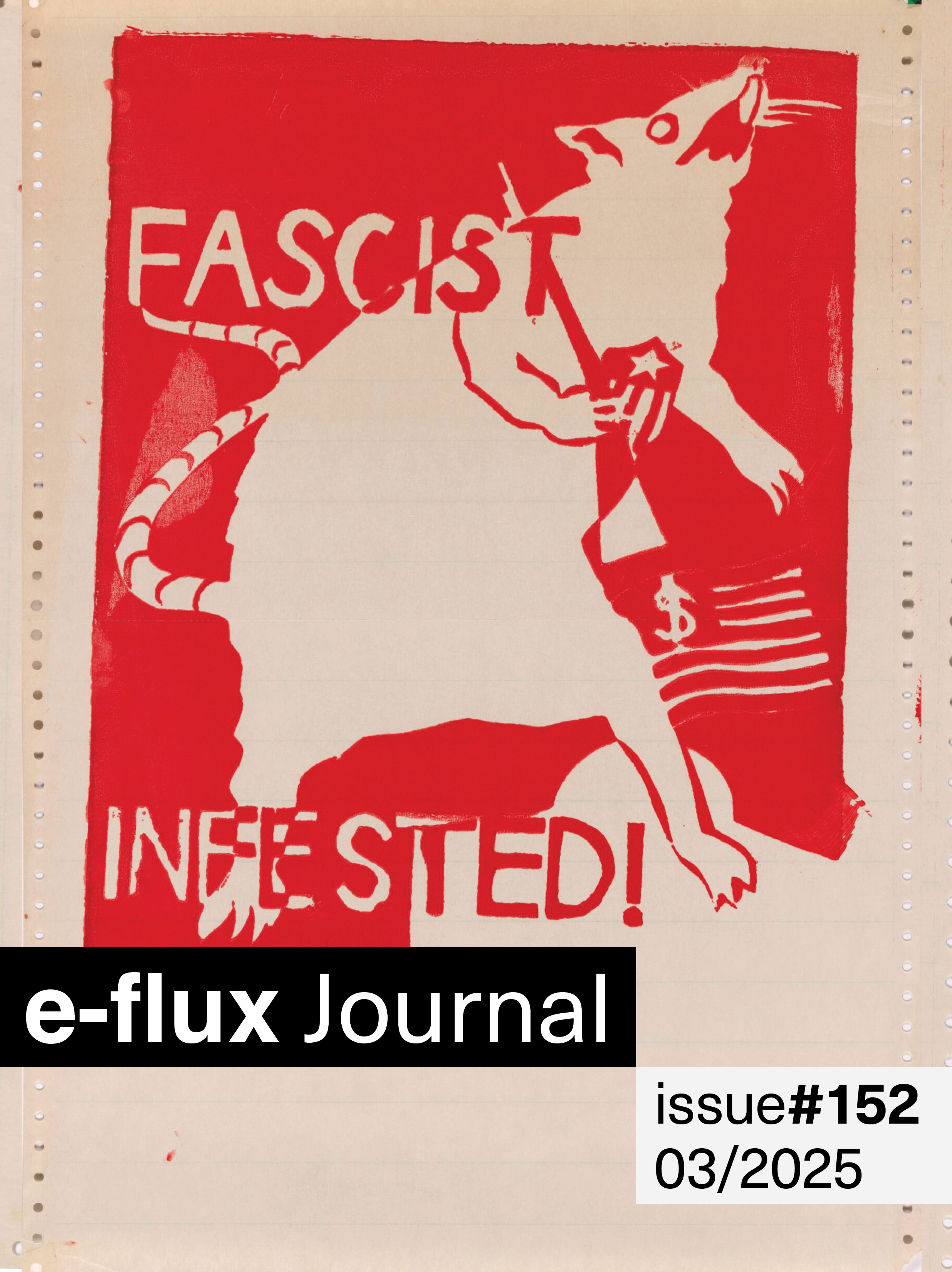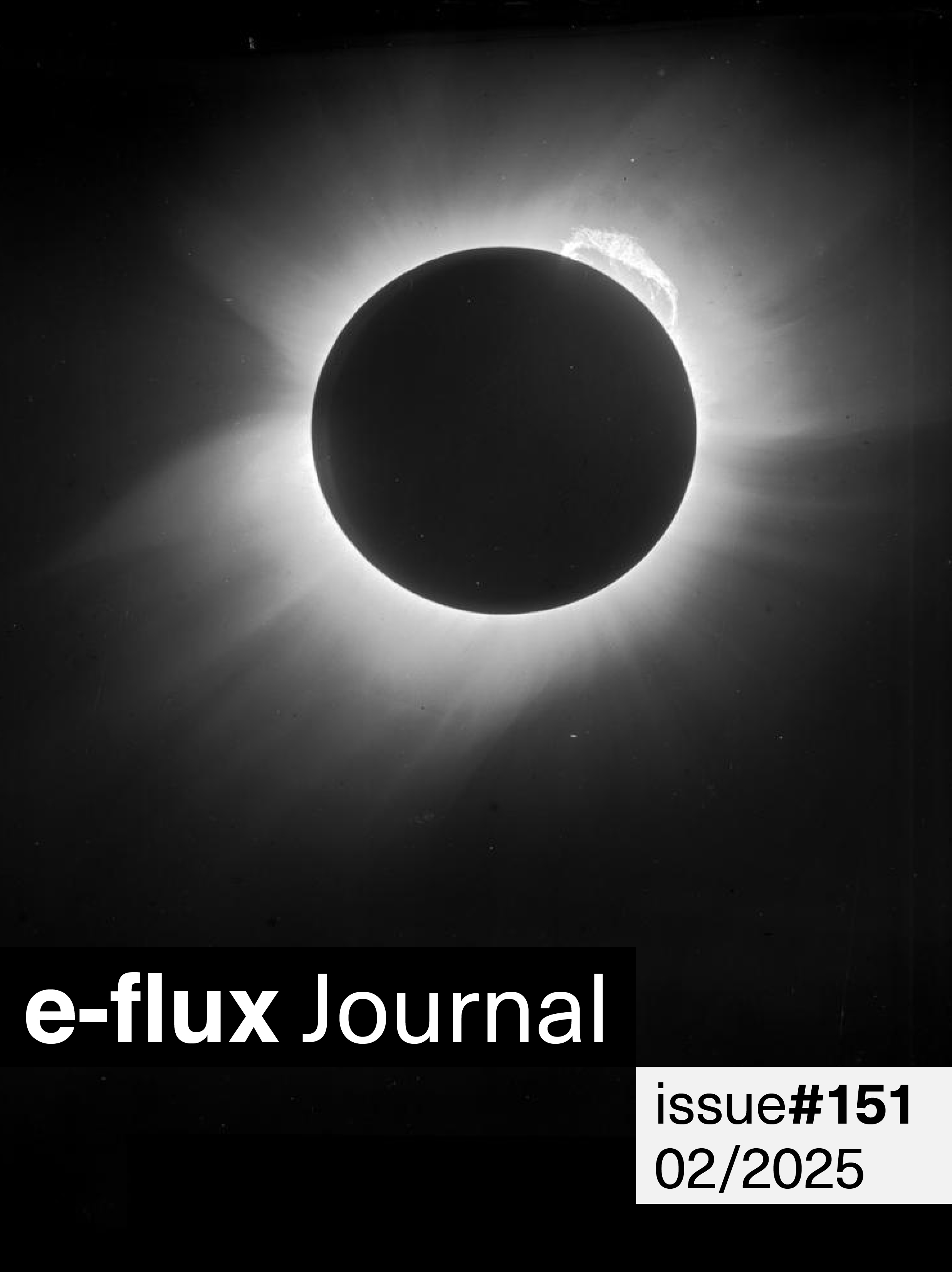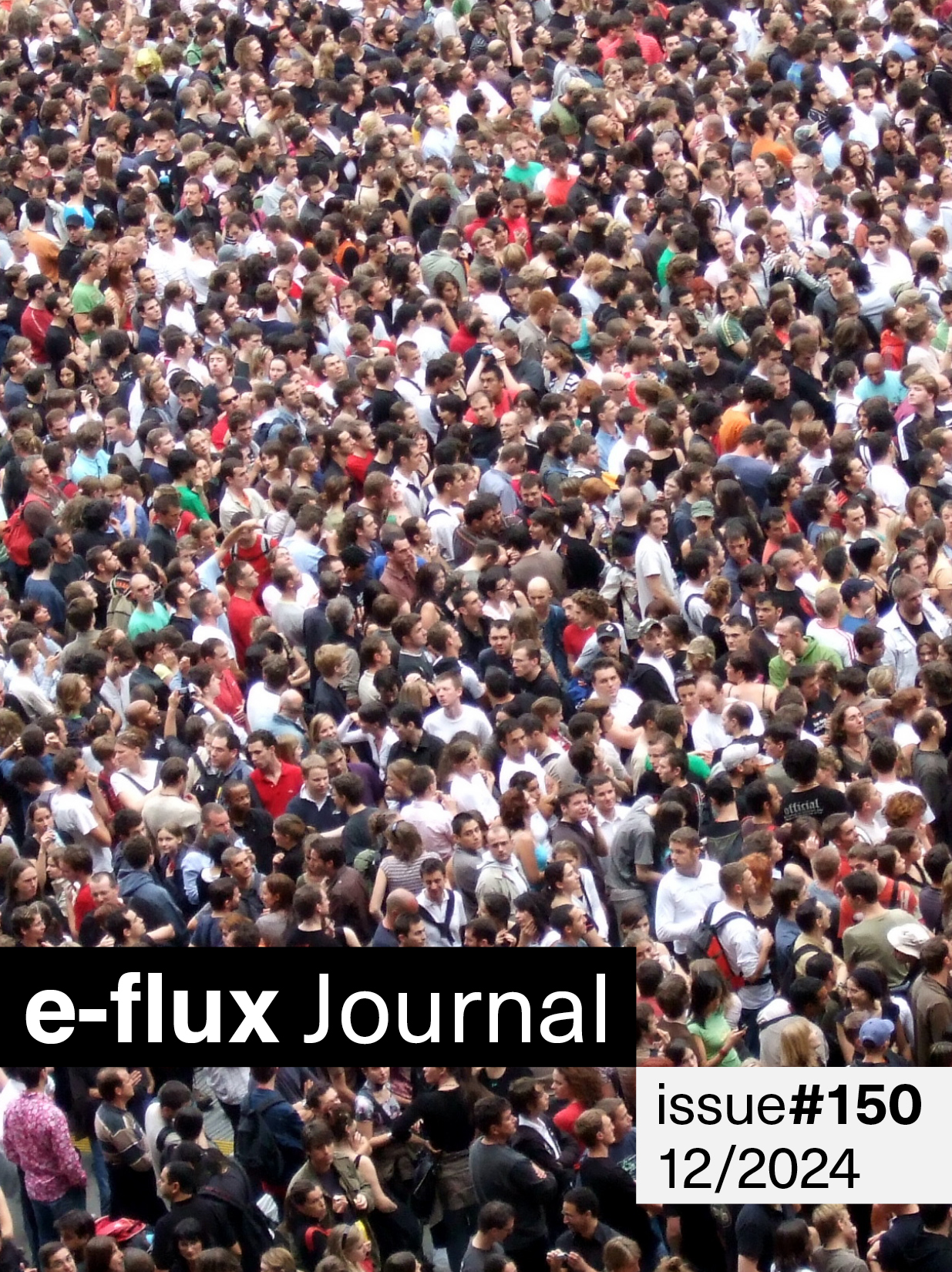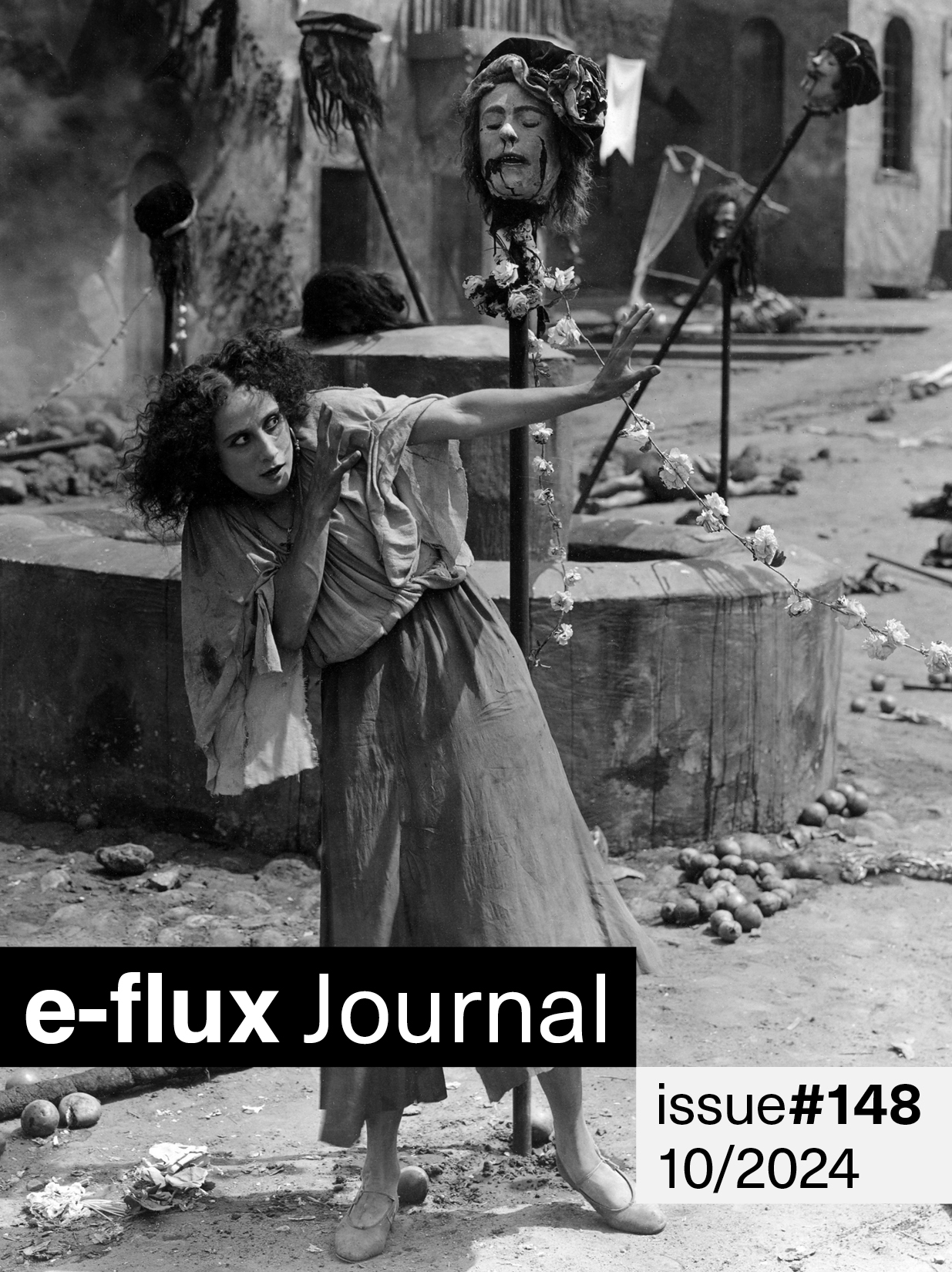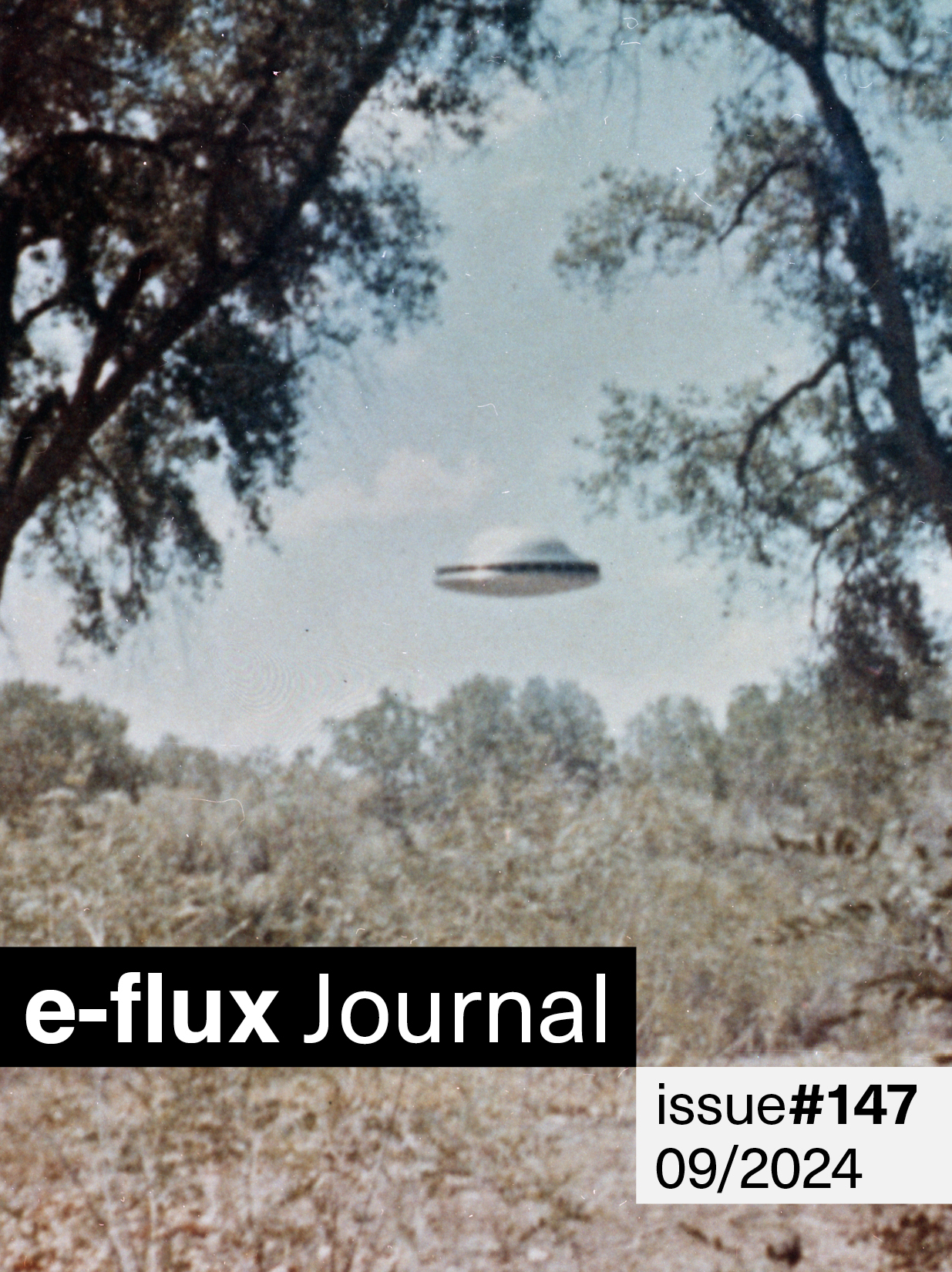e-flux journal issue 80
with Amy Ireland, Charles Tonderai Mudede, Boris Groys, Nana Adusei-Poku, Achille Mbembe, Barbara Cassin, Carol Yinghua Lu, and Jonas Staal
Division is the characteristic habit of humanity: ēthos anthropōi daimōn, as Heraclitus had it. Demons for division, we divide and are divided. Taken over by divisions within ourselves, the demonic appears as the divided self. Wherever the self realizes an apparent struggle, whenever one is possessed by another, the demon is present. Possession dramatizes self-production as a fight for local control. Demonology is the science of these heteronomous selves, these others inside us. “From the beginning,” writes Boris Groys in this issue, “the contemporary artist is demonic: he is possessed by himself and cannot be relieved of his demons.”
To be an artist is to produce a self in excess of the self, a surplus self, straddling the borders of the human individual. “Ah!” we say, looking at a can of excrement. “It is a Manzoni!” The artist lends their name to a career composed of inhuman children. But artists are not the only multiple ones; there are others equally excessive, equivocally unaccountable. “Machines, women—demons, if you will—align on the dark side of the screen: the inhuman surplus of a black circuit,” writes Amy Ireland in “Dark Circuit: Code for the Numbers to Come.” Should those left unrecognized seek numbers for themselves? Or prefer to remain outside the circle of our collective ’countability?
Animals, too, exemplify a self that is not yet a citizen, even as they are deployed as sensors. In horror movies the dogs always bark at the demon’s invisible presence. The horses startle; a flock of birds shudders, astonished, into the air. They perceive in advance the arrival of our divided nature. Charles Tonderai Mudede, in “Black Mirror Body,” considers the animal consistency beneath our various projects and projections of some timeless immaterial humanism.
Achille Mbembe details the deep intellectual and material history of such apprehensions in “Difference and Self-Determination,” from his forthcoming Critique of Black Reason. How does blackness apprehend itself when it has been interpolated—the word is too gentle in this case—for centuries as the opposite, or absence, of reason? In “On Being Present Where You Wish to Disappear,” Nana Adusei-Poku considers a contemporary manifestation of the same association, common in the art world, of nothingness, universality, and whiteness.
Language is a potential answer to the universal question, perhaps, but not a singular one. There are many particular languages, and Barbara Cassin takes up the question of what it means to speak more than one by starting with the significance of the first—what she calls “maternal language.” Carol Yinghua Lu considers the mother tongue of Chinese contemporary art by sketching its prehistory in the decades since the end of the Cultural Revolution. Meanwhile, in “Assemblism,” Jonas Staal draws on the work of Judith Butler to develop a vision for a new, decidedly less demonic politics. Is it possible to imagine an assembly of everyone, demons and divisions included?
—Editors
In this issue:
Amy Ireland—Black Circuit: Code for the Numbers to Come
His goal is to bring about a transition from the masculine Aeon of Horus to a new age—an age presided over by qualities imputed to the female demon: fire, blood, the unconscious; a material, sexual drive and a paradoxical knowledge beyond sense … the wages of which are nothing less than the ego-identity of Man. It is to be the end, effectively, of “his” world. Her cipher in the Cult of Ma’at is 0, and she appears in the major arcana of the Thoth Tarot entangled with the Beast as Lust, to which is attributed the serpent’s letter ט, and thereby the number 9. In her guise as harlot, it is said that Babalon is bound to “yield herself up to everything that liveth,” but it is by means of this very yielding (“subduing the strength” of those with whom she lies via the prescribed passivity of this role) that her devastating power is activated: “Because she hath made her self the servant of each, therefore is she become the mistress of all. Not as yet canst thou comprehend her glory.”
Charles Tonderai Mudede—Black Mirror Body
The human body is built for equality in much the same way a horse is built to run fast or a cow is built to chew grass. For example, there is a sharp and unusual contrast between the human iris (which can be black, or brown, or blue, or what have you) and the sclera (which is always white). This is not an accident. It has an important function, which gamblers are very familiar with. It makes us more transparent. Human eyes provide information to other humans about what a human individual sees. If the eyes of a person who one is looking at move to the left, one becomes aware that something unseen is happening in that direction. The other person’s eyes become our eyes.
Boris Groys—Dmitri Prigov: Haunted Spaces
Image production primarily serves the goal of self-protection. By producing images the artist diverts the evil eye of the Other (and as Lacan says, the eye of the Other is always an evil eye) from his own body to an image that functions as a trap for this evil eye. The gaze of the Other becomes caught by and in the image—and, thus, neutralized, paralyzed. One can argue that the growing importance of visual art in Prigov’s work had to do with protection against the dark, demonic forces of Chaos that destroyed the Soviet Cosmos. As long as this Cosmos still existed, Prigov placed his body in the center of public space—or at least in the center of performance space. But the moment this Cosmos collapsed, Prigov’s art took a self-protective turn.
Nana Adusei-Poku—On Being Present Where You Wish to Disappear
This black abyss, which in the Fanon passage starts with a negative connotation that we find can be overwritten, is rich with knowledge and potential. It is incomparable, perhaps wholly unrelated, to the nothingness that often fills empty museums. The nothingness that Audre Lorde spoke out from, that Fanon was trapped in, that Fred Moten versifies, that Miles Davis and Dorothy Ashby riffed on—this nothingness is not absence but foundation. It is multifarious and stands in stark opposition to any white absence of understanding and space.
Achille Mbembe—Difference and Self-Determination
The plantation regime and, later, the colonial regime presented a problem by making race a principle of the exercise of power, a rule of sociability, and a mechanism for training people in behaviors aimed at the growth of economic profitability. Modern ideas of liberty, equality, and democracy are, from this point of view, historically inseparable from the reality of slavery. It was in the Caribbean, specifically on the small island of Barbados, that the reality took shape for the first time before spreading to the English colonies of North America. There, racial domination would survive almost all historical moments: the revolution in the eighteenth century, the Civil War and Reconstruction in the nineteenth, and even the great struggles for civil rights a century later. Revolution carried out in the name of liberty and equality accommodated itself quite well to the practice of slavery and racial segregation.
Barbara Cassin—More Than One Language
Derrida’s phrase “A language is not something that belongs” also means that, when you speak a language, you are the one that belongs to it as much as it belongs to you. Within it, you can always invent but ultimately, through you, thanks to you, it is the one that is constantly inventing itself. You are not the one who possesses it because it is the one that obligates and makes you. It doesn’t belong to you: you belong to it and it belongs to people other than you. That is what a maternal language is.
Carol Yinghua Lu—The Missing Front Line
Young artists, novel and appealing, are quickly drawn into the art system. Frequently they enjoy an extended honeymoon period of being viewed, supported, consumed, discussed, and described. Meanwhile, artists who have been working since the 1970s and ’80s are highlighted as part of a particular art movement, even being lauded as the movement’s leading or representative figures, gaining the affirmation of the art system. These older artists have been brought into international exhibitions that focus on presenting Chinese art, and have been the center of attention for collectors and the art market. However, after so many years, their work remains undescribed in terms of its art-historical relevance.
Jonas Staal—Assemblism
The collective gathering of bodies in the form of an assembly is an inherent act of resistance against the lack of care that a given regime provides to these bodies. When masses of people lose their houses due to a criminal mortgage system and assemble with their tents in a park, then this assembly is a response to a dysfunctional or absent collective infrastructure. The assembly is simultaneously a direct expression of the condition of precarity and a protest against it.
Further material related to this issue will be published on e-flux conversations. Stay tuned.
The print edition of e-flux journal can be found at:
Amsterdam: De Appel arts centre / Rijksakademie van beeldende kunsten Andratx: CCA Andratx Antwerp: M HKA Museum van Hedendaagse Kunst Århus: Kunsthal Aarhus Athens: OMMU Auckland: split/fountain Austin: Arthouse at the Jones Center Baden-Baden: Staatliche Kunsthalle Baden-Baden Banff: Walter Phillips Gallery, The Banff Centre Barcelona: Arts Santa Mònica / MACBA Basel: Kunsthalle Basel / Museum für Gegenwartskunst Basel Beijing and Guangzhou: Vitamin Creative Space Beirut: 98weeks Belgrade: Cultural Center of Belgrade Bergen: Bergen Kunsthall / Rakett Berlin: b_books / Berliner Künstlerprogramm – DAAD / Bücherbogen am Savignyplatz GmbH / Books People Places / do you read me? / Haus der Kulturen der Welt / Motto / Neuer Berliner Kunstverein (n.b.k.) / Pro qm Belfast: Platform Arts Bern: Kunsthalle Bern / Lehrerzimmer Bialystok: Arsenal Gallery Bielefeld: Bielefelder Kunstverein Biella: UNIDEE - University of Ideas, Cittadellarte - Fondazione Pistoletto Onlus Birmingham: Eastside Projects / Ikon Gallery Bologna: MAMbo – Museo d'Arte Moderna di Bologna Bregenz: Kunsthaus Bregenz Bristol: Arnolfini Brussels: WIELS Contemporary Art Centre Bucharest: National Museum of Contemporary Art Bucharest (MNAC) / Pavilion Unicredit Cairo: Beirut / Contemporary Image Collective (CIC) / Townhouse Gallery Calgary: The New Gallery Cambridge: Wysing Arts Center Castello: Espai d´art contemporani de Castelló (EACC) Chicago: Graham Foundation / Reva and David Logan Center for the Arts / The Renaissance Society at The University of Chicago Cologne: Kölnischer Kunstverein Copenhagen: Overgaden Derry: CCA Derry~Londonderry Dijon: Les Ateliers Vortex Dublin: Dublin City Gallery The Hugh Lane / Project Arts Centre Dusseldorf: Kunstverein für die Rheinlande und Westfalen Eindhoven: Van Abbemuseum Frankfurt: Städelschule / Portikus Gdansk: Łaźnia Centre For Contemporary Art Geneva: Centre de la photographie Ghent: S.M.A.K. Glasgow: CCA Centre for Contemporary Arts / Glasgow Sculpture Studios Graz: Grazer Kunstverein / IZK Institute for Contemporary Art, TU Graz / Kunsthaus Graz / Künstlerhaus KM– / para_SITE Gallery / Grijon: LABoral Centre for Art and Creative Industries Groningen: University of Groningen Hamburg: Kunstverein in Hamburg Helsinki: Museum of Contemporary Art Kiasma Hobart: CAST Gallery / INFLIGHT Hong Kong: Asia Art Archive Iași: theartstudent at the University of Fine Arts, Iași Innsbruck: Galerie im Taxispalais Istanbul: BAS / DEPO / Galeri Zilberman / SALT Johannesburg: Center for Historical Reenactments Kansas City: La Cucaracha Press Klagenfurt: Kunstraum Lakeside Kristiansand: SKMU Sørlandets Kunstmuseum Kyiv: Visual Culture Research Center Leeds: Pavilion Lisbon: Maumaus, Escola de Artes Visuais / Oporto / Kunsthalle Lissabon Ljubljana: Moderna galerija Llandudno: MOSTYN London: Architectural Association—Bedford Press / Calvert 22 / Chisenhale Gallery / Gasworks / ICA / Serpentine Gallery / The Showroom / Visiting Arts Los Angeles: REDCAT Loughborough: Radar, Loughborough University Luxembourg: Casino Luxembourg Madrid: Brumaria / CA2M / PENSART Maastricht: Jan van Eyck Academie Marfa: Ballroom Marfa Melbourne: Monash University Museum of Art (MUMA) / World Food Books Merrylands: Cerdon College Mexico City: Librería Casa Bosques / Proyectos Monclova Milan: Fondazione Nicola Trussardi / HangarBicocca Milton Keynes: MK Gallery Minneapolis: Walker Art Center Monaco: Nouveau Musée National de Monaco Moncton: Fixed Cog Hero (a bicycle courier company) Montreal: Canadian Centre for Architecture (CCA) Moscow: Garage Center for Contemporary Culture Munich: Haus der Kunst / Museum Villa Stuck / Walther Koenig Bookshop New Delhi: Sarai CSDS New York: e-flux / Independent Curators International (ICI) / Printed Matter, Inc / McNally Jackson Nottingham: Nottingham Contemporary North Little Rock: Good Weather Gallery Omaha: Bemis Center for Contemporary Arts Oslo: Kunstnernes hus Oxford: Modern Art Oxford Padona: Fondazione March Per L'Arte Contemporanea Paris: castillo/corrales – Section 7 Books / Centre Pompidou / Les Laboratoires d'Aubervilliers Philadelphia: Bodega Pori: Pori Art Museum Portland: Portland Institute for Contemporary Art (PICA) / Publication Studio Porto: Museu de Arte Contemporânea de Serralves Prague: DOX Centre for Contemporary Art Prishtina: Stacion – Center for Contemporary Art Prishtina Providence: AS220 Reykjavik: Reykjavik Art Museum Riga: kim? Rio de Janeiro: Capacete / A Gentil Carioca Rome: MACRO Museo d'Arte Contemporanea Roma / Opera Rebis Rotterdam: Piet Zwart Institute / Witte de With | Center for Contemporary Art Saint-Nazaire: Le Grand Cafe, centre d'art contemporain Salzburg: Salzburger Kunstverein San Antonio: Artpace San Sebastián: Centro Internacional Cultura Contemporanea São Paulo: KUNSTHALLE São Paulo / Master in Visual Arts, Faculdade Santa Marcelina Sarajevo: Sarajevo Center for Contemporary Art (SCCA) Seoul: The Books / The Book Society Sherbrooke: Foreman Art Gallery of Bishop's University Singapore: The Ngee Ann Kongsi Library Skopje: Press to Exit Project Space Sofia: ICA-Sofia / Sofia Art Gallery / SWIMMING POOL St Erme Outre et Ramecourt: Performing Arts Forum St Louis: White Flag Projects Stockholm: Bonniers Konsthall / Iaspis / Index - The Swedish Contemporary Art Foundation / Konstfack, University College of Art, Craft and Design / Konsthall C / Tensta konsthall Stuttgart: Württembergischer Kunstverein Stuttgart Tallinn: Kumu Art Museum of Estonia The Hague: Stroom Den Haag Toronto: Art Metropole / Mercer Union / The Power Plant Torun: Centre of Contemporary Art Znaki Czasu in Torun (CoCA) Toowoomba: Raygun Contemporary Art Projects Trieste: Trieste Contemporanea Trondheim: NTNU University Library Umeå: Bildmuseet, Umeå University Utrecht: BAK, basis voor actuele kunst / Casco – Office for Art, Design and Theory Vaduz: Kunstmuseum Liechtenstein Valencia: IVAM–Biblioteca Valletta: Malta Contemporary Art Foundation Vancouver: Artspeak / Fillip—Motto / Morris and Helen Belkin Art Gallery, University of British Columbia / READ Books, Charles H. Scott Gallery, Emily Carr University of Art and Design Venice: The Biennale Library-ASAC Vienna: Kunsthalle Wien / Salon für Kunstbuch—21er Haus Vigo: MARCO, Museo de Arte Contemporanea de Vigo Vilnius: Contemporary Art Centre (CAC) Vitoria-Gasteiz: Centro Cultural Montehermoso Kulturunea Visby: BAC – Baltic Art Center Warsaw: Zachęta National Gallery of Art Wiesbaden: Nassauischer Kunstverein (NKV) Yerevan: Armenian Center For Contemporary Experimental Art (NPAK) Zagreb: Galerija Miroslav Kraljevic / Gallery Nova / DeLVe | Institute for Duration, Location and Variables Zurich: Postgraduate Program in Curating, Zürich University of the Arts / Shedhalle / White Space
